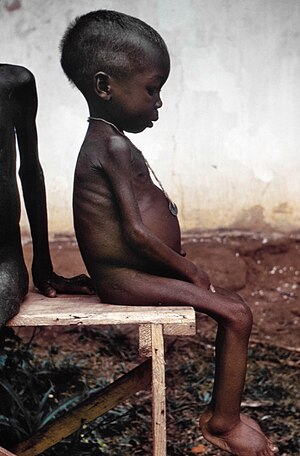Kwashiorkor
Severe protein malnutrition / From Wikipedia, the free encyclopedia
Dear Wikiwand AI, let's keep it short by simply answering these key questions:
Can you list the top facts and stats about Kwashiorkor?
Summarize this article for a 10 years old
Kwashiorkor (/ˌkwɒʃiˈɔːrkɔːr, -kər/ KWOSH-ee-OR-kor, -kər, is also KWASH-)[1] is a form of severe protein malnutrition characterized by edema and an enlarged liver with fatty infiltrates.[2] It is thought to be caused by sufficient calorie intake, but with insufficient protein consumption (or lack of good quality protein), which distinguishes it from marasmus. Recent studies have found that a lack of antioxidant micronutrients such as β-carotene, lycopene, other carotenoids, and vitamin C as well as the presence of aflatoxins may play a role in the development of the disease.[3] However, the exact cause of kwashiorkor is still unknown. Inadequate food supply is correlated with occurrences of kwashiorkor; occurrences in high income countries are rare.[4] It occurs amongst weaning children to ages of about five years old.[2]
| Kwashiorkor | |
|---|---|
 | |
| A young girl with kwashiorkor in a relief camp during the Biafra War | |
| Specialty | Pediatrics |
Conditions analogous to kwashiorkor were well documented around the world throughout history.[5] However, Jamaican pediatrician Cicely Williams introduced the term in 1935, two years after she published the disease's first formal description. Williams was the first to conduct research on kwashiorkor and differentiate it from other dietary deficiencies. She was the first to suggest that this might be a deficiency of protein.[6][7] The name is derived from the Ga language of coastal Ghana, translated as "the sickness the baby gets when the new baby comes" or "the disease of the deposed child", and reflecting the development of the condition in an older child who has been weaned from the breast when a younger sibling comes.[8] Breast milk contains amino acids vital to a child's growth. In at-risk populations, kwashiorkor may develop after children are weaned from breast milk and begin consuming a diet high in carbohydrates, including maize, cassava or rice.[2][6]